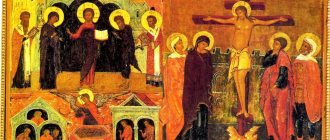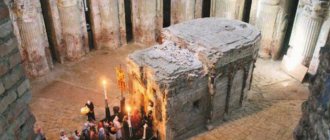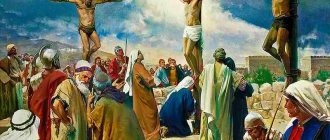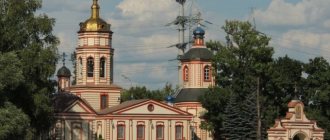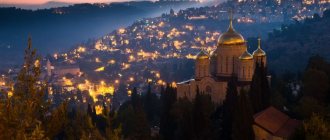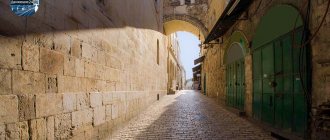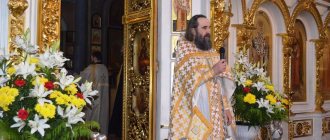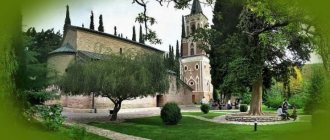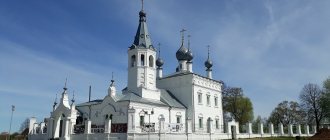The Orthodox cross is a real shrine. Especially revered in Russia is the Life-Giving Cross, which is located about three and a half hours drive from Moscow in a place called Godenovo in the Yaroslavl region.
There is a large amount of evidence that miracles of healing occur here. Moreover, the cross in the village of Godenovo heals not only the body, but also the soul. Moreover, today 12 copies of this shrine have been installed in Russia. One of them was brought to Sevastopol, at the height of the events of the Kyiv Maidan. Residents of Crimea prayed that they could live peacefully in their own country. Very little time passed, and Crimea returned to Russian jurisdiction, and without bloodshed.
The Lugansk church, where another miraculous cross is located, despite the active hostilities around it, was never damaged by bombs or shelling.
The sisters at the Nikolsky Monastery in Godenovo keep a special book with evidence of healings and miracles, even with relevant medical documents attached. Anyone who visits the village of Godenovo can see it. A parishioner with stage 4 cancer, after going to the monastery, often read the akathist, preparing to accept death. However, she recovered. Her letter, along with the doctors’ verdict before and after the trip, is in the temple.
The chronicle of the wonderful stories of the Godenovo cross begins from the 16th-17th centuries, and the latest records date back to 2021. For example, the parents of a nine-year-old girl who was completely cured of a severe form of epilepsy. Before that, doctors refused her. At four years old, the little girl said that it was not pills that would help her, but the Lord. A week after the girl visited the Life-Giving Cross, the attacks happened less and less often.
But, perhaps, the main miracle of the Lord should be considered the repeated attempts of the atheists in the past to destroy the Life-Giving Cross, but it literally did not burn in the water and did not drown in the water. Despite the years of oblivion during the Soviet regime, the miraculous cross today attracts a huge number of believers (on the days of the festive service their number reaches 10 thousand), and the veneration of the shrine is akin to the way they pray to Seraphim of Sarov or the Moscow Matronushka.
History of the Life-Giving Cross and the Temple itself
The history of the life-giving cross in Godenovo begins with the fact that in a swampy area in 1423, shepherds saw a cross hanging in the air surrounded by “ineffable light.” The crucifix was made in an unusual way, and a voice emanated from it, foreshadowing the appearance of a temple at this place, after which grace would come, and all those who prayed to St. Nicholas the Wonderworker would receive healing. Nicholas the Saint himself stood in front of the Cross, holding the Holy Gospel in his hands. The shepherds, returning home, told their fellow villagers about everything.
After the blessing of the Rostov bishop, it was decided to build the church where indicated in the vision. But the builders did not dare to build it on swamp soils and laid the foundation a little to the side. However, the very next day, miraculously, the building ended up in the place where the appearance of the Cross took place. Then at night a river appeared among the swamps, carrying away part of the swamp slurry, and the Temple was opened in a dry area called Nikolsky Pogost. The Life-Giving Cross became its main attraction and shrine.
In the first half of the 18th century, the priest at the temple, from the words of local residents, wrote down the history of its appearance, attaching a list of miracles that he himself heard about and those that he found in old documents. And in the place where they initially wanted to build a church, they erected a chapel, but it has not survived to this day.
The temple survived several fires, but each time the Cross was found on the ashes unharmed. The stone building was erected only in the 18th century (second half). The monastery had three altars: the Cross of the Lord, St. Nicholas and the Intercession of the Virgin Mary. Until 1917, the temple had more than one and a half thousand parishioners.
In the early thirties of the last century, the church was closed, and the Bolsheviks wanted to completely destroy the shrine. Those who were especially zealous wanted to take out the Cross to burn it. But the Crucifix suddenly became so heavy that they simply could not lift it. Meanwhile, more than once during the religious procession, the monks without any problems lifted him and carried him out of the temple.
They tried to saw the cross with saws and chop it with axes, but they did not cause any harm to it. There is also a story that one of the most furious atheists in his hearts hit the Crucifix with an ax and a piece of the little finger of the image of Jesus broke off.
A few days later, the god-fighter’s leg became inflamed and gangrene began. After this, guards were placed at the doors of the temple, and the church was locked. But the parishioners bribed the guards and moved them at night to Godenovo, to the church named after St. John Chrysostom. Since then the Cross has been called Goden's Cross. According to eyewitnesses who lived in the village of Zakharovo, this happened in 1933. 64 years passed before the Cross in Godenovo again became available for public pilgrimage.
Since 1996, the church that sheltered the shrine has become part of the monastery courtyard. The nuns of the Nikolskaya monastery constantly live near the temple in Godenovo. Restoration of the Crucifixion itself began only in 2002. It was carried out by specialists from the Russian Museum of St. Petersburg. A year later, the work was completed, and the shrine again regained its former splendor.
Why did Queen Helen look for the execution weapon?
And now let’s imagine a woman who lived for 80 years in such a perception of this execution, who suddenly fell in love with the instrument of another person’s death. Cross!
For me, the question has always been: why did Queen Helena, the elderly mother of Emperor Constantine, suddenly organize an expedition to Aelia Capitolina (present-day Jerusalem) for one thing: to find the Cross of Christ?! What exactly attracted this woman to such a task? Find the execution weapon? Yes. Execution of Jesus Christ. But why the execution weapon? Why wasn't she in a hurry to find other artifacts?
The legend and description of Eusebius of Caesarea reveal to us the features of the first written excavations of the queen. She herself did not leave the excavation site, not only supervising, but also actively participating. The elderly matron sat on the curule seat under a large umbrella all day, despite the scorching sun. She watched with interest the work of the hired diggers, encouraging them with small and light gold coins, like petals, which she threw into the garbage that they had to scoop out of the abandoned tank. And this forced them to throw out garbage faster to get to the desired gold.
How to get to Godenovo to the Cross
You can get to the place in an organized manner, with the help of a pilgrimage service, or on your own. Today this is a very popular route. Godenovo is located in the Yaroslavl region, away from the highway, between Pereslavl and Rostov. The distance from the latter is 20 km, from Pereslavl – 40 km. The closest town on the way to the shrine is Petrovsky. From here you can get to Godenovo by bus. If you travel from Moscow by train or train, you will need a transfer; there is no direct transport.
Travelers from other cities also first get to Petrovsky, and from there to the Temple. By car from Moscow you should travel along the Yaroslavskoye Highway from the Moscow Ring Road, which is 160 km. to Petrovsk, and then turn following the signs, they indicate the road to Godenovo.
Believers are received here every day from 7.30 to 20.00. Services are held on Mondays and Tuesdays if holidays occur on those days. On other days, the liturgy begins at nine in the morning. You can find out a detailed schedule of services on the website.
The feast days of the Holy Cross are celebrated in the third week of Lent, June 11, August 14 and September 27. He truly has the gift of healing and calming all those who suffer. The main thing is pure thoughts, sincere prayer for healing or help (for yourself, for your loved ones), and your requests will not go unanswered. Everyone will have their own feelings. Many pilgrims find their way to God in this way - after clear evidence that he is present in their lives, helping and forgiving a person for his imperfections.
To main
Tradition of crucifixion
Actually, the Romans crucified in different ways. We have a lot of evidence that this type of execution was not always classic. For example, when a huge number of people had to be crucified, anything could be used for this: pillars, trees, house walls, doors.
When examining the Shroud of Turin, it was discovered that the nailing of the hands occurred in the wrist area. And a fragment of a heel bone found in Palestine in the burial of a crucified youth tells us that they could have nailed their feet with one large nail into the heel bone through wooden planks. Perhaps this is the end of the artifacts testifying to the ancient execution of the Romans, which they adopted from the Carthaginians.
But the main thing in this execution was the killing itself by strangulation. This was the principle of fanaticism on such a terrible gallows! Crucifixion has always been the most shameful execution.
Usually they crucified people naked, often pouring excrement or slop over their bodies so that a swarm of flies would overcome the unfortunate people. Stones were often thrown at those crucified, multiplying the bleeding wounds. Vile performances were staged under the martyrs on the crosses, with which the dignity of man was humiliated.
Execution on the cross testified to the complete helplessness of the executed. In ancient times, the helpless were not loved, they became objects of attack and humiliation.
Legends about the discovery of a life-giving shrine
Slavic and Greek legends tell of a Cross that has eight ends and is made of three parts. These legends are based on the words of the prophet Isaiah, where he names three types of wood that will bring glory to the foot.
Cypress served as the material for the pillar. For the crossbar, to which the Holy hands of the Son of God were nailed, they used pine or pine, in a different way. The lower part of the instrument of death was made of cedar, and the feet of the Innocent Lamb were nailed to it.
After the death of Jesus, Equal-to-the-Apostles Empress Helena gave orders to find the location of the shrine.
Isaiah 60:13 “The glory of Lebanon will come to you, cypress and tree and cedar together, to adorn the place of My sanctuary, and I will glorify My footstool.”
Icon “The Finding of the Cross”
The Jews hid the holy burial place of the cross of Jesus from Christians until one of them, Judas, was tortured by order of Helen. (The story goes that he was subsequently baptized and ordained as a bishop in Jerusalem).
The Jewish prophet Judas was a descendant of the first martyr Stephen, who died under Christ. The prophet's father knew about the place where the three crucifixion instruments were buried, but strictly kept this secret. According to legend, the discovery of a Christian relic will be the beginning of the end of the supremacy of the Jewish religion over all others.
About other holidays of the Lord:
- Ascension of the Lord
- Transfiguration
- Exaltation of the Holy Cross
Judas was thrown into a dry well, where he was supposed to die from exhaustion until he indicated the burial place of the shrine. After seven days of prayers and appeals to God, the prophet was given a sign.
For reference! Information about the person who found the burial place of the relic has the meaning of legend. Some sources indicate the name of Christian Ablavius.
The place indicated by the prophet gave off a light steam filled with a sweet aroma. Elena ordered excavations at the site of Christ's execution, where the honest tree was discovered.
How the authenticity of the weapon of Christ's crucifixion was determined
During excavations of the holy place, three crosses were found. It was not possible to determine which of them belonged to Christ. According to one legend, the faith of Jerusalem Bishop Macarius helped, who appealed to God and asked for help.
The sign came in answer to prayer. God showed Macarius that a woman was dying in their country, suffering for a long time from an incurable disease. She will recover from the touch of the life-giving shrine. The trees on which the robbers were crucified did not produce any result, but from the precious shrine the dying woman sighed and immediately recovered.
All over the world there are several versions of the acquisition of a Christian relic. Each of them has its adherents.
According to the command of Helen, allegedly given to her by an angel, the Life-Giving Cross was distributed in parts to different parts of the earth.
Perhaps these are legends, but the Life-Giving Cross and even its parts still exist today and give believers in this shrine more and more miracles and answers to prayers.
Rewards from Jerusalem with pieces from the Life-Giving Tree are the most valuable.
Other versions of the origin of the honorable trees of the Holy Cross (Honey Savior)
According to history, the Honey Savior is celebrated as a memory of two events that occurred simultaneously in Rus' under Prince Bogolyubsky and during the Byzantine campaign of Emperor Manuel. The first of them fought with the Volga Bulgars, and the Byzantines fought with the Turks.
In both cases, the enemy's strength far exceeded the defenders of their land. Under the cover of the icons of the Savior and the Mother of God, both Christian troops raised a fervent prayer to Heaven - a petition for the granting of victory. God heard the cries of believing people and rewarded them according to their faith. In the sky above both armies stood the life-giving tree of the Cross of the Lord as a Divine weapon against enemies.
This happened on August 14, the day when the celebration of the appearance of the Life-Giving Shrine is celebrated.
Important! On this day, the Assumption Fast begins, so there is a strict restriction on food, entertainment and amusements. On August 14, it is customary to go to church and bless honey and poppy seeds.
Origin of the life-giving tree
The history of the Life-giving Cross of the Lord is based on legends about the life-giving tree on which Jesus was crucified, but which still gives miracles of healing and liberation.
The Bible does not answer the question of what kind of wood was used to make the instrument of death on which Christ was crucified. In the Gospels it is already being prepared as an instrument of crucifixion.
Apocryphal sources store a lot of interesting reliable data about the origin of the legendary tree.
According to the legend of the Bogomils, a Christian movement of the 5th century that came from Bulgaria, the tree of paradise of good and evil fell into three parts during the expulsion of Adam and Eve. The central part remained in the Garden of Eden, and subsequently the Cross was made from it for the crucifixion of Christ.
According to the Golden Legend, Adam's son Seth went to the gates of the Garden of Eden with a request to give him oil to anoint his dying father. Archangel Michael refused him, saying that this oil was closed for 5.5 thousand years before the time of the birth of Jesus, but presented Seth with a branch from the tree of good and evil. Seth did not find his father alive; a wreath was woven from a branch of the legendary tree and placed on Adam’s head during burial.
Death of Adam, artist - Pierro Dela Francesca
From this branch subsequently grew a tree, cut down by the servants of King Solomon to build the temple in Jerusalem. Due to the discrepancy in size, it was used as a support for a bridge.
The Queen of Sheba, who had the gift of prophecy when visiting King Solomon, stopped near the bridge and knelt in front of the historical tree. According to her, this tree is destined to become an instrument of death for the Savior of the world, after which the Jews will face ruin.
King Solomon knew the Queen of Sheba and her gift of vision well. The prediction seriously frightened him. By order of the king, the tree was dismantled from the bridge and buried.
The wood of this timber was subsequently used to build a pool in Bethesda, whose water attracted the crippled with its healing qualities.
When Jesus was arrested, this tree emerged from the foot of the pool, a cypress from which the trunk of the Life-Giving Shrine was made, the crossbars were made of pine and cedar.
Important! The history of the life-giving Cross of the Lord formed the basis of the Feast of the First Savior, which is celebrated on August 14. It is popularly known as Honey Spas.
Features of worship
The rite of raising the Cross of the Lord is part of the bishop's service, which takes place on the evening before the Exaltation of the Cross. At this service, the patriarch or bishop raises the cross three times, and the choir sings a hundred times: “Lord, have mercy.” Then the cross is washed with fragrant water and the next day after the liturgy it is distributed to the people.
Photo ugraeparhia.ru
In ordinary churches, where the service is performed without a bishop, the holiday also has its own characteristics. First of all, this is the carrying of the Cross into the middle of the church at the end of the evening service with prostrations to the ground and the singing of the troparion: “We bow to Your Cross, O Master, and glorify Your holy resurrection.”
Our homeland
One of the Orthodox states where the largest number of particles of the Holy Cross is located is Our Motherland. At the moment, particles of the shrine are kept in the Epiphany Cathedral in Yelokhov (Moscow), Trinity-Sergius Lavra (Sergiev Posad), Alexander-Svirsky Monastery (Leningrad Region), Annunciation Monastery (Nizhny Novgorod), Resurrection-Feodorovsky Monastery (Ivanovo Region), Holy Cross Monastery monastery (Ekaterinburg), Intercession Alexander Nevsky Monastery (Novosibirsk region), Holy Cross Kyltovo convent (Komi Republic) and a number of other places.
The essence of the holiday:
The cross is a symbol of the redemptive feat of the Son of God, Who paid with His human life for the sins of each of us, and then rose again and called us to follow Him into eternal life.
One of the Sunday stichera (church hymns) calls the Cross “a weapon against the devil” that the Lord gave us. Of course, the Cross does not save us by itself, but as a visible image of our unity with the Savior. And, worshiping the Cross, we worship, as it is sung in the same stichera, “Thy burial and rising.”
